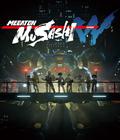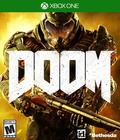Buy Doom
If you're a gamer of a certain age or one who appreciates older titles, Doom was the game that, along with Wolfenstein 3D, put id Software on the map. The duo of games that ran on MS-DOS defined the first-person shooter genre and became the measuring sticks for games for many years. It was one of the first titles to embrace user-made creations, and new ones are still coming out to this day. It was also one of the titles that pushed the boundaries for network play and coined the term "deathmatch." It is a classic in every sense of the word, which is why there was a lot of fanfare when a simply titled sequel, Doom, was announced at last year's E3.
The game offers three major modes. The first, Campaign, starts with you strapped to an operating table and about to be sacrificed. You break free and try to get a firearm and your suit of armor, and you quickly discover that the UAC was conducting operations on Mars to solve the galaxy's energy crisis. To do this, they harvested the energy of Hell and converted it to something usable. Unfortunately, their lead scientist became fascinated with the realm and tried to enlarge the rift into Hell, killing almost everyone on Mars by releasing demons onto the planet. As the lone space marine, you make it your mission to stop her at all costs.
As with the previous entries and expansion packs, the story is simply a framework for the game's action. It never made much sense in those cases, so there was no need to remedy that in this outing. Having said that, the idea of making energy out of a location is absurd enough that it works. The in-game cut scenes and incidental dialogue play the concept straight, and it works well enough that you'll roll with it, even though you're fighting the result of something akin to an oil leak.
The action starts almost immediately after you finish the short introductory cut scene, so you discover that the core of what defines Doom is completely intact. Your arsenal of weaponry is pretty basic, with only one or two that can be considered futuristic, even if they were old weapons featured in earlier games. You have health and armor systems, and they can only be replenished by grabbing pick-ups in the level. There's no such thing as a limit to what you can hold in your arsenal, and while you have limited ammo for each gun, there's no need to perform a reload action. There are even secret areas in each stage and a tally at the end of each level to let you know how many secrets you've discovered. Most importantly, the game moves quickly. Your speed while ducking is equal to the sprint speed in other games. While fully upright, your movement can sometimes feel like you have a speed movement booster in Unreal Tournament. It feels very good to move and jump without worrying about weight.
With that core in place, Doom does a number of things that feel like natural additions to the series. The secret areas you uncover now contain modules that help you power up your suit. You're outfitted with expected things, such as resiliency from environmental damage and the ability to spot collectible items from a greater distance, but they don't feel like they imbalance the game too much. You can find drones throughout the level that contain modifications to your existing weapons, like giving your shotgun a grenade launcher or outfitting your pistol with a charge shot. Those mods can also be powered up with faster reloading and increased cooldown. Equipment can also be outfitted to your character, so you have things that are new to the series, like grenades, which are infinite but are bound by long cooldown meters. Challenges also play a big part here, since completing them gives you even more points for weapon and suit modifications. Finding stray argent energy orbs gives you permanent upgrades to armor, health or ammo.
Some of the more interesting additions to the game are runes and their associated challenges. Scattered throughout are special glyphs that, when activated, take you to a different section of the game. These areas contain specialized challenges, such as blowing up barrels with a pistol or defeating enemies using only one type of weapon. All of the challenges take place under strict time constraints, and time is only added if you perform a kill. The challenges can be very tough, especially the later ones, but completing them gives you some big advantages, such as the ability to pick up items from a greater distance or increase the amount obtained per pick-up.
The other interesting addition is the glory kill. Activated when you stagger an enemy and go in for a melee attack, the glory kills feature some rather brutal execution methods that don't necessarily involve firearms: rip apart an enemy's leg or arm and bash them with it, cave in an enemy's skull with their shoulder-mounted cannon, or kick away an enemy before they explode. While this sounds like another opportunity to take away control from the player to show them something cool, the actual animations are about two seconds long. There's some benefit, since you gain health for these executions. If you use the chainsaw for glory kills, the scenes last a little bit longer but benefit you with larger ammo restoration instead of health. It seems like chainsaw executions can be abused, but the use of fuel for the saw and varying levels of fuel consumption for each kill means that the maneuver can only be used sparingly.
The combination of these elements means that you get to fall into a cadence when engaged in a fight. Standing back and picking off shots can only get you so far, as the game is tailored for aggression over caution. You'll still need to dodge attacks, especially if you're mobbed in all directions, but more often than not, you'll succeed by pushing through the hordes and mowing down everyone with your guns while performing a glory kill or two to recover from the beating you just took. Combined with the faster movement and firefights, you'll experience an adrenaline rush like no other.
Part of the reason the combat feels so right has to do with the monsters, all of which are either modifications to the known bestiary or new creatures. Whether they're melee-specific creatures or ones that throw projectiles, every monster displays lots of aggression to overwhelm you and provide lots of targets for carnage. Unlike the previous games in the series, the enemies here are quite good at dodging your fire or hopping all over the place, so the fights are much more challenging, especially if you're fighting a large number of enemies. This increases tenfold when you're fighting in boss battles, as they demand dexterity and some thought as you read their patterns, get in a few good shots, and try not to get pummeled.
The level design also hearkens back to the design of the classic games, since the title is heavily married to the idea of colored card keys and the corresponding locked doors. The game is evenly split between straightforward paths and areas that require backtracking to hunt for keys and their corresponding doors. The levels are quite large, so you'll have a good chance of getting lost but not because everything looks too similar.
However, Doom tends to rely on one design trait that becomes a crutch later on: the monster closet. There are many areas within a level where you're locked in a room and forced to kill all of the demons to escape or progress. Often, they'll come under the guise of you destroying a monstrous growth from hell and then dealing with the denizens that pop out. It's a great way to facilitate aggressive combat, but the game takes this route so often that clearing monster closets fails to instill excitement.
Multiplayer makes up the game's second mode, and for many, this is a big one since the original title pioneered online play. If you haven't already participated in the betas, then you'll be both surprised and disappointed to see the game employ modern mechanics. The game starts you with weapon loadouts of two guns max and one piece of equipment, with no chance to procure different weaponry on the field either through designated spots or from fallen foes and allies. Medals are here, as is an XP system that governs things from character customization to new weapons and taunts. Also, all of the modes are team-based, so those who want to participate in one-versus-all situations are out of luck.
If you aren't bothered by those concessions, then you'll discover that the multiplayer doesn't invoke much from its past. Instead, the game seems to take the rest of its multiplayer blueprint from id's other classic shooting series, Quake. All of the arenas sport some verticality, while others require good jumping skills to take shortcuts or reach better equipment. In this case, the equipment is usually armor and health, diminishing the accomplishment you feel when you reach out-of-the-way locales.
While this sounds like a damning of the mode, it really isn't. The game retains a fast pace while being balanced with difficult opponents. Headshots and more powerful weapons always guarantee quick kills, but you can hold your own with just a chaingun. The addition of a demon rune, a power-up that lets you transform into one of four powerful enemies, can help you turn the tide of battle. It never gets old when you grab a bunch of kills or take down a minion of Hell. Despite the hangups, the multiplayer remains a fun experience.
Interestingly, while Doom features a number of modes, the public only seems interested in a core few. The two territory-based modes don't feature too many players, and the clan wars deathmatch mode is similarly sparse. Freeze Tag sounds interesting, but it is impossible to find enough people to get a match going. On the other hand, the Team Deathmatch mode is swarming with people, so it is extremely easy to get a match going with a full house. You'll see empty spots fill up once people drop, so there's rarely a time when you're playing a small group match. Likewise, the variant where you have to confirm a kill by capturing souls is similarly crowded with players. It's more beneficial for those who like demon hunting, since those kills are worth more points. For a title that was maligned in the betas, the multiplayer seems to have started out in a rather healthy position.
Snapmap is the final mode, and while some may initially see it as a nice little bonus, it's a huge part of the game. The mode allows you to build your own stages for the game, and while the various tutorials can make it seem intimidating, the process is quite easy since it feels like you're putting together LEGO blocks. After putting in your level framework, you start adding other details, like weapon location, monsters, explosive items, and so forth. You can even throw in sound emitters and make some basic puzzles. Publishing and downloading the stages is easy, and there's even a wiki, so you can learn more advanced techniques.
The real joy of the mode comes from the library of levels ready available for public consumption. There's a wide breadth of not just single player levels but co-op and competitive ones as well. The mix between original creations and remakes of old Doom levels is staggering and even in just one weekend there have been quite a few stages that are well designed and infinitely replayable. As more people come to grips with the system, you can expect the number of available stages to only get higher.
Though it is a mode with near-infinite possibilities, it come with one major drawback: loading times. The other modes already have some decent load times, but unless you're dying constantly in the campaign or failing the rune challenges, you'll never be bothered by them since the levels are long enough to make up for it. The stages are short enough that you'll realize the load times are indeed quite lengthy, so it can be a test of patience to go through a bunch in one sitting.
Running on id Tech 6, the company's latest engine, the graphics for Doom look quite nice. The game may be guilty of adopting the grays and browns that almost overwhelmed the previous generation of games, but when you consider the setting, the color scheme is forgivable. In a roundabout way, it makes the other colors stand out much more, giving players a helpful guiding light. Like many other games in this console generation, the title is almost overflowing with smoke and particle effects, with heat waves from gas pipes shimmering and embers flying everywhere. The monster designs are just as grotesque as you'd expect, but there are enough touches to help you see how the designs have evolved from the original title. The game also shines in the gore department, especially with the glory kills showing off some pretty gnarly blows. The only thing that the game falters on in this department is the loading of textures, as you'll see many new elements start as shiny blobs before quickly adding on the layers of detail. This was present in previous id Tech engine games, so it's a little disappointing to see it appear here as well.
Much like the graphics, the sound is also excellent. Your hero is mute, but everyone else who's capable of speech turns in terrific performances. The game does a good job of not inundating you with lines at every single moment, so dialogue feels rather special even if it's for something rather mundane. The effects provide lots of good bass for gunfire and explosions, while the constant screams and shrieks of demons give you a great image of the horrors you'll face on Mars and Hell. More impressive is the music, which feels like an amalgamation of Doom's metal approach and Quake's more industrial sound. It shines during battles, where it accents the action instead of overwhelming it, and it does a great job of driving home the series' feeling of constant combat. The soundtrack also manages to add variety in the form of some satanic choir pieces when you're visiting Hell; it's a nice touch that adds to the mood when you're not engaged in combat.
Your enjoyment of Doom is going to depend greatly on the mode you're playing and your acceptance of the tweaks to the classic formula. In multiplayer, you'll have fun as long as you keep in mind that this is a blend of every other multiplayer first-person shooter instead of simply being Doom with prettier graphics. If you're playing the campaign, it feels like a welcome evolution of the series, since the classic elements meld rather well with the modern touches. If your attention is on Snapmap, then you'll find that the game has some long legs thanks to an easy-to-learn system that has already produced loads of content for solo and multiplayer situations. Either way, you're getting a complete package that celebrates the pure adrenaline-pumping action that brought so many to the genre in the first place. Doom is absolutely a worthy entry to any genre fan's library.
Score: 8.5/10
More articles about Doom











 DOOM returns as a brutally fun and challenging modern-day shooter experience.
DOOM returns as a brutally fun and challenging modern-day shooter experience.






















